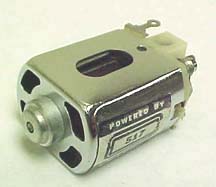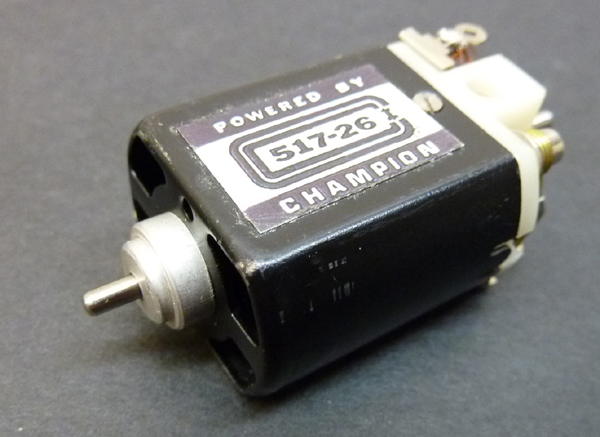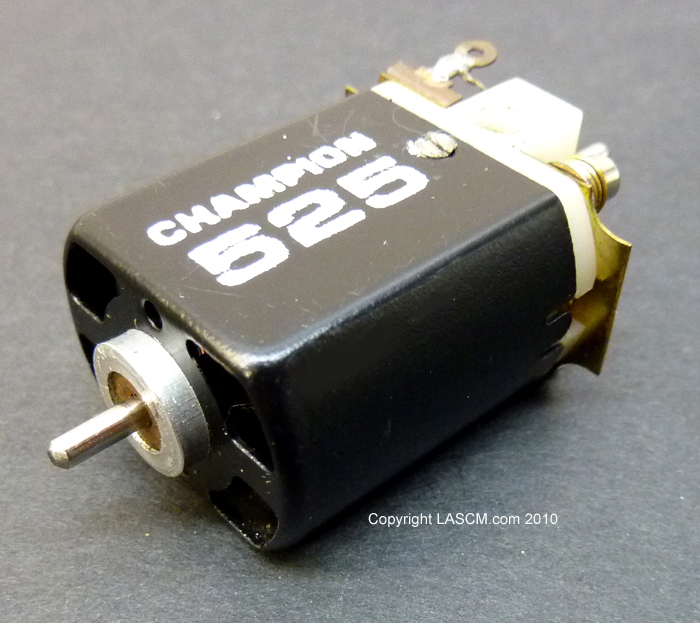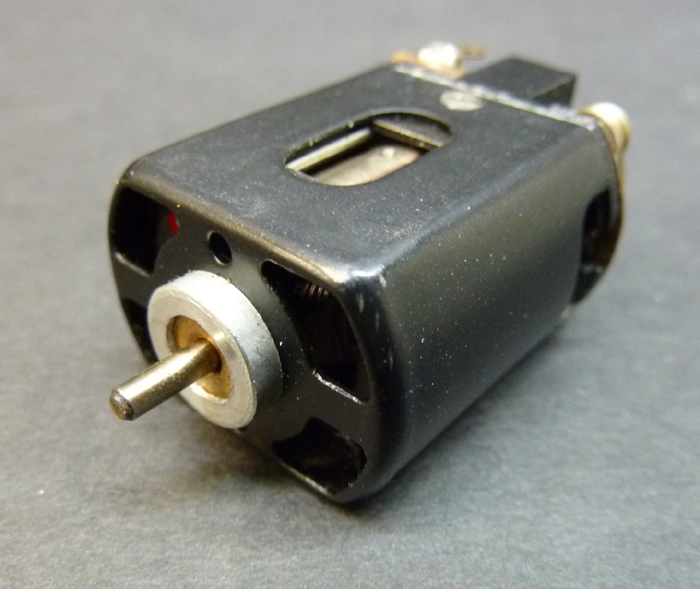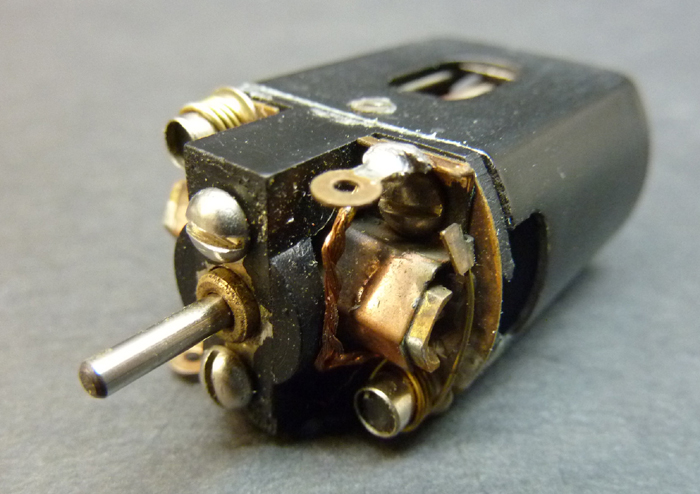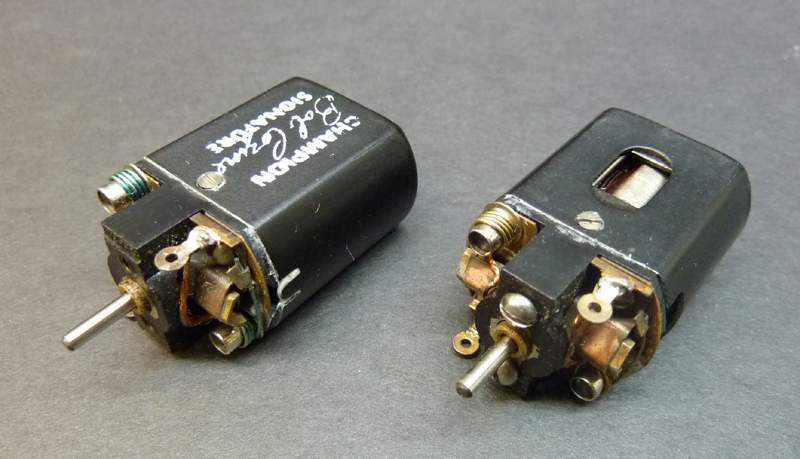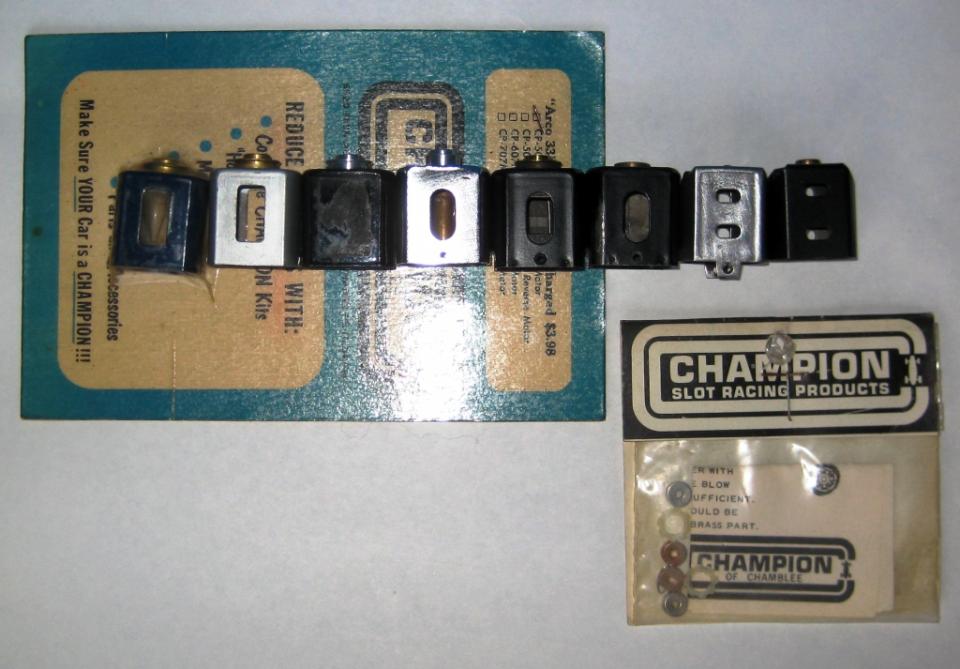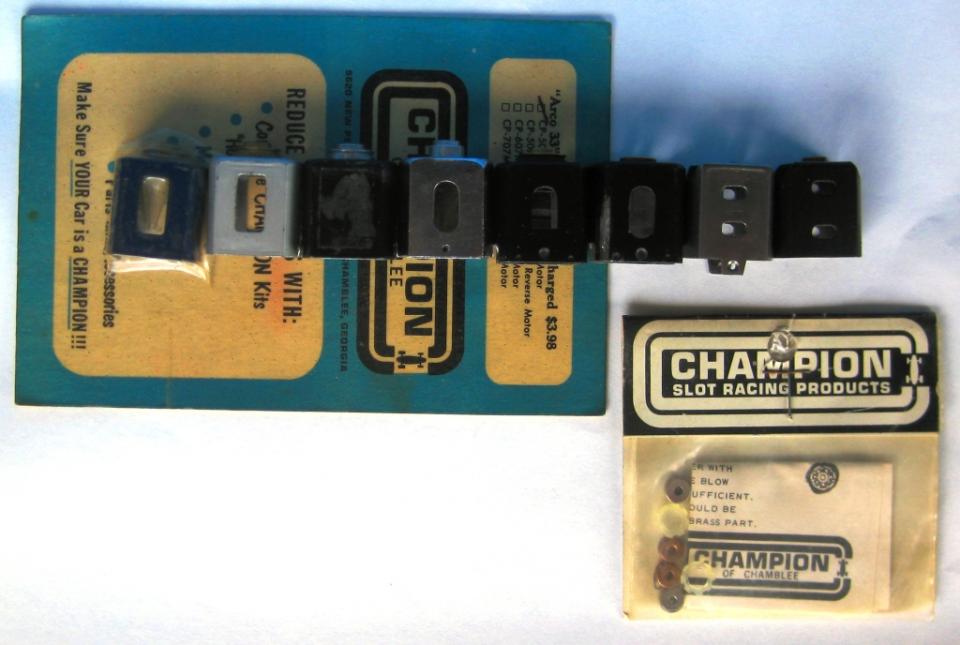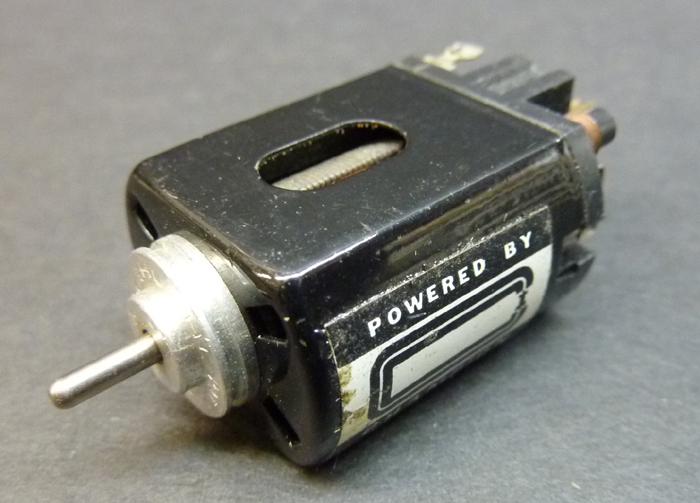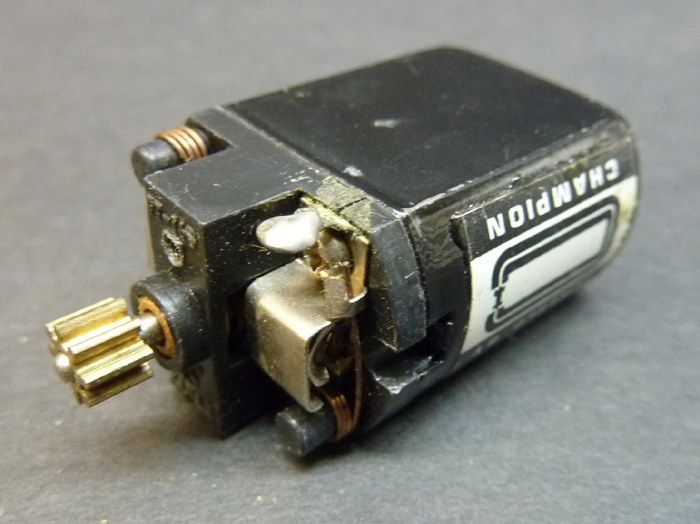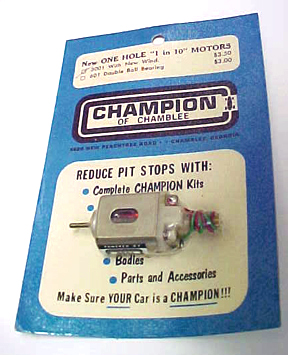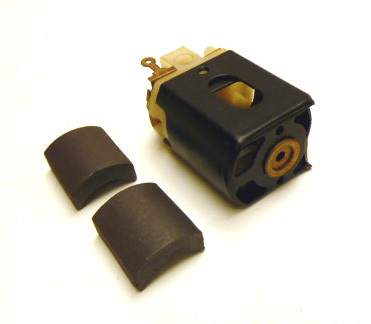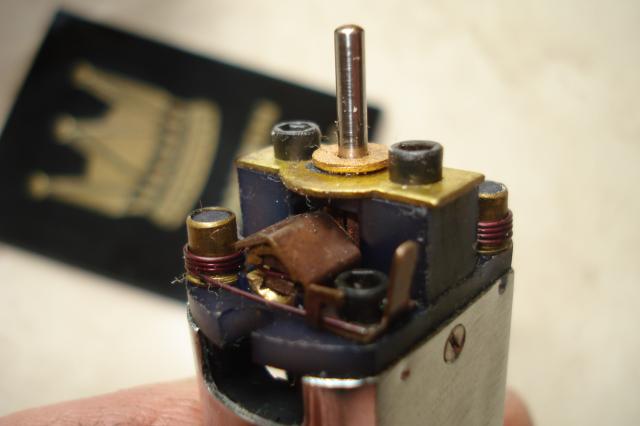Just as a point of referrence, I got out of slots in May, 1968 and the 220' track closed the very next month, so I would go along with Rick's theory of 2nd quarter 1968.

Two vintage Champion motors
#26

Posted 09 April 2013 - 04:31 PM
"We offer prompt service... no matter how long it takes!"
"We're not happy unless you're not happy"
"You want it when?"
#27

Posted 09 April 2013 - 09:04 PM
Just for setting the stage, the 517 and 617 American-made motors with the thick chrome plated cases were released to the trade on September 1st, 1967, well ahead of the new Mura "American" motor. Now...
I went through the 1968 and 1969 catalogs and price lists and it definitely did not happen in 1968. However, as of may 1st, 1968, the "new black case" was introduced as a complete motor, as the 517-26-B motor (obviously with a 26-wire armature), the "B" standing for "black". It was priced at $11.95, one dollar more than the chrome plated 517-26 motor.
The 517 (chrome case) was also available with 27 and 28 wire.
There was no mention anywhere of a stabilized bearing and all the motors offered had the first type of can bearing seen in all the 517s:
The new motor looked like this:
Both these receive a smaller aluminum housing than the Mabuchi FT16D, with a standard bronze bushing inside, non floating.
By 1968's end (September), the 517 is discontinued and replaced by the 525, that receives a modified bearing, basically the same as above but with a shorter outer housing due to the switch from endbell-side drive to can-side drive, space is at a premium. The 525 is a scarce motor today and looks like this:
You can clearly see the modified bearing. So far, all these motors use the same endbell, introduced in 1967 for the 507R motor that used a special Mabuchi case with rectangular vents, using a smaller bronze bearing than normal production motors. This endbell was made of white Celcon, a material with a higher melting point than Delrin as used by Mabuchi.
Now for 1969:
The March 1st price (good to June 1st) list shows the new "535" that replaces the 525, now obsolete. The 535 retains the same can bearing as the 525, but has cutouts on the sides of the can for ventilation and uses a whole new endbell made of black plastic with a molded-in bearing. That endbell is the best Champion ever made for the 16D-size motors. It also receives machine screws instead of self tapping, so there is less deformation, and it fits snuggly inside the can, no need for shims.
A genuine 535 is today a rare motor as they were used, and used up. It looks like this:
Note the side vents and the lack of markings on the motor. Not even a lousy sticker.
A view from the endbell:
The 535 armature receives a 25 AWG wire, but there are 3 more motors: the 536, 537 and 538 with 26, 27 or 28 wire.
A new "545 Bob Cozine Signature" is also available, same general features with 25 wire, but special care is taken in its assembly. Bob Cozine said to me that he had nothing to do with those motors...
The 545 Cozine next to the 535:
So far, no case with Mabuchi "stabilized" bearing... ![]() But the black case is offered separately with the magnet shims and the two tiny screws to hold the endbell, stock # 517-BMCX.
But the black case is offered separately with the magnet shims and the two tiny screws to hold the endbell, stock # 517-BMCX.
And... no mention of anything like it in any other 1969 catalog!
Comes 1970, and... bingo. The February 1970 catalog/price list has the following:
"New 5524 motor
Silicone stabilized gimble (sic) bearing case. 007 armature w/drill blank shaft. Shimmed Arco DZ mags. High temp Orange endbell (yep, that dreadful thing) fully bullet proofed. #256 cap head machine screws (actually a lie since they are self tapping), 16-D brushes. Absolute space age tolerances on our armatures (they must have been talking North Korean space age...) 24 gauge wire (hence the 5524 name). Absolute latest winds. All Orange Pickers now in stock wound after September 1st".
And... 5525 and 5526 are simply the same with 25 or 26 wire...
Now for the "loose" motor case with the "stabilized" bearing:
the stock number is 5502-MC, and it came only fitted with Arco DZ mags and shims, and "quantity limited due to large amount of hand labor". At $6.98...
They must not have made too many of those with that Mabuchi bearing, and the question is, WHY?
I think I have an answer: they must have run out of the aluminum/brass combo bearings, and could not get any production going, so they may have either bought some bearings from Mabuchi (very likely) or demolished some old obsolete Mabuchi cases (like used on their 700-series motors that by late 1969, they could not even give away) and recycled the bearings on drilled black cases. That's my best guess... and would have been typical of Champion. And guess what? The next motors had the new and common one-piece large bronze bushing, that is found on all the later Group-7, Group-15 and Group-20 motors produced well into the 1970s.
Makes sense?
So no cookie for anyone, we were all a bit wet with the dates.
- Mark Onofri likes this
Philippe de Lespinay
#28

Posted 09 April 2013 - 10:14 PM
The 16D and 36D Mabuchi brass gimbel bearing housings are identical inside and out except for the following exceptions:
1. The 16D housing has a rotation arrow stamped into it, the 36D does not.
2. The 36D housing has a slightly larger hole in it due to the larger shaft size.
Both utilize the same 5 pronged retainer ring and felt wick. The only difference is the i.d. of the gimbel bushing. The external dimensions of the bushing are the same.
A couple years ago I took the brass housing out of a Cox 250 and installed it in a Monogram 110 can and it works perfectly to this day.
Why did I do that? Just to prove it could be done and that it works.
"We offer prompt service... no matter how long it takes!"
"We're not happy unless you're not happy"
"You want it when?"
#29

Posted 10 April 2013 - 01:06 AM
Thanks Dokk,
So Q4 of 69 developed to be included in the 2/70 catalog release. A key to the later date (1970) could be the packaging.
It was the black/white stapled and the blue blister packaging when I got out (moved away 6/68) and when I stopped back in 1973 the blue checker product cards were in.
Does anyone remember when Champion changed over to the blue checker header card?
BTW: The 552X set-up on hand has the screws are 2/56 allen head .. w/ no threaded inserts, 16D size brush holders, has the direction arrow on the bushing end.
The fact that these Champion/Mabuchi half breed cans came later (not first) in the game and between two bushings that fit the can properly .... my guess is you are correct on how this outdated unreliable floating housing came back into service. The large (late) oilite was not as good of a choice due to more mass the then Alum/Oilite combo.
Question ... what hardware is on the 525 shown above.

Bob Israelite
#30

Posted 10 April 2013 - 12:16 PM
NO COOKIE???? ![]()
Dang.
Good presentation Philippe, and good detective work pinning down that ebay motor and my mystery black Champ can photos.
But I'm bummed about the cookie. ![]()
Steve Okeefe
I build what I likes, and I likes what I build
#31

Posted 10 April 2013 - 03:22 PM
Rick Thigpen
Check out Steve Okeefe's great web site at its new home here at Slotblog:
The Independent Scratchbuilder
There's much more to come...
#33

Posted 10 April 2013 - 04:16 PM
You are missing a few along the way but it is a start...
Does anyone remember when Champion changed over to the blue checker header card?
From an analysis of the products, sometimes in 1969 and they were used along the orange checker as well as the plain blue and white. Whatever was available at the time of need.
Question ... what hardware is on the 525 shown above.
All the "black" endbells that preceded the dreadful ones with the brass plate have machine screws, not self-tapping. But they were only used on the "53" and "54" motors, while they were also (unfortunately briefly) sold separately.
But I'm bummed about the cookie.
Cookies are not good for you... ![]()
Seriously, the more I look at all this stuff, the more I realize how hectic it must have been...
Now when I purchased the Champion archive on the LASCM's behalf, there were 9and we still have them) all kinds of can samples from the American can manufacturer, and some have different diameters for the bearing hole. All the samples are bagged, dated and clearly identified. So now I will have to go deeper to find the "correct" can for the Mabuchi bearing if indeed it was done that way, and pinpoint a date, so cookies may not be out yet! ![]()
To be continued. In any case, always an interesting subject for the aficionado. ![]()
Philippe de Lespinay
#34

Posted 10 April 2013 - 08:56 PM
IIRC ... 507BB Celcon endbell, ground balanced 517 style EBD arm.
Missing from the pictures -
5001 chrome one hole
525 un-vented thick can, w/ tabs for endbell
55xx - w/ alum/bronze carrier
Late Mabuchi short* can BB chrome, alum carrier
Late Mabuchi short* can BB cad plate, bronze carrier
504 - Mustard colored stock Mabuchi can
517 w/ large Oilite
Surely, there must be more.
* short stamping in can topside for magnet retention tabs.

Bob Israelite
#35

Posted 10 April 2013 - 09:31 PM
Interesting is the black one hole thin alum/BB can 3rd from the left in top picture. I think it was a Euro ... came dressed up as a with Champion label on bottom and directional paper arrow label on side........
It is the can from a Champion "5007" motor made by Mabuchi for Champion. Dual shaft, red armature wire, one-hole can and black standard Cox-style endbell. The arrow label MAY mean that it was marketed in the UK.
This motor was issued in 1968, is the last complete motor Champion purchased from Mabuchi and was used in quite a few RTR using the old sheet aluminum inline chassis, as a stressed member.
5001 chrome one hole
Here is one, and it was the stock motor preceding the 5007. Issued in 1967:
For the others you mention, they have a story of their own.
Philippe de Lespinay
#36

Posted 10 April 2013 - 10:45 PM
It's interesting that the black can above (post 35) does not have the small screw holes punched on either of the flat sides as almost every other MabuchiChampion can did.
Also, I checked my 3 Champion cans with the brass Mabuchi gimbel housings. The black one, like Steve's on the previous page has the rotation arrow stamped in it, so it came from a 16D can.
The 2 chrome cans do not have the rotation arrow stamped in either one of the gimbel housings, thus they came from 36D cans. Also neither chrome can has the silicone around the gimbel bushing.
My black can is the only one I have that has the dimples. Were those limited to the black ones or are there any chrome examples?
If anyone wants an NOS Champion plastic retainer ring and ball bearing, Professor Motor now sells them:
http://www.professor...-p/mot1642b.htm
Okay, Dokk, what is your explaination of this can that Scott Bader has on epay now?
"We offer prompt service... no matter how long it takes!"
"We're not happy unless you're not happy"
"You want it when?"
#37

Posted 11 April 2013 - 09:04 AM
It is simple: in the early 1970s, arm stacks became shorter, especially for group 15 motors. The can was too long with the bearing affixed in the standard position, so Champion simply reversed it, shortening the arm space inside, so that less spacers would be needed.
Also note the cut for angle-winder use to clear the axle.
However, Scott makes it nice for you: this can should have one of the awful orange endbells, and instead he provides a NOS 517 endbell that is a much better deal!
Philippe de Lespinay
#38

Posted 14 April 2013 - 12:38 AM
The timing of this thread is "uncanny" ![]()
I've been looking through some bits and pieces recently, and trying to make time-line of the few 1960's Champion "16D" cans that I have...(looks like I might have a long way to go if I want to make a "collection" ![]() )
)
The above pics and posts have been great! Love this sort of stuff...
One thing though...
Do ya suppose we could move the information over to the Motors and Motor Building forum? More specifically, the "Understanding the Evolution of the "16d" Motor" thread?
Whadoyathink??? To consolidate the info...
I had a bit of a hard time remembering and then finding where I'd seen all these cool pictures, and great info....almost forgot that it was in the ebay forum...
Tom Hemmes
Insert witty phrase here...
#39

Posted 14 April 2013 - 10:00 AM
Do ya suppose we could move the information over to the Motors and Motor Building forum? More specifically, the "Understanding the Evolution of the "16d" Motor" thread?
Whadoyathink??? To consolidate the info...
Ask the boss, the Cheaterman...
It's interesting that the black can above (post 35) does not have the small screw holes punched on either of the flat sides as almost every other MabuchiChampion can did.
On a stock motor that was not designed to be rewound, what would the need have been?
Also, I checked my 3 Champion cans with the brass Mabuchi gimbel housings. The black one, like Steve's on the previous page has the rotation arrow stamped in it, so it came from a 16D can.
Correct, or directly from Mabuchi and applied to those cans either in USA or in Japan, and one will never know.
The 2 chrome cans do not have the rotation arrow stamped in either one of the gimbel housings, thus they came from 36D cans. Also neither chrome can has the silicone around the gimbel bushing.
Uh, the American-made chrome cans never got that Mabuchi bearing housing as far as i know, can you show one?
My black can is the only one I have that has the dimples. Were those limited to the black ones or are there any chrome examples?
The motor on sale in the UK has the dimples, so your answer is yes...
However, that motor has the later bearing style that came well after the advent of the black cans, meaning at first that Champion liquidated some of their older chrome plated cans well after they were obsolete, dumping them on their UK importer... but this assessment is not correct since the cans have the side vents like the "535" motors, so they were produced AFTER the black cans were already in service.
More konfuzion...
Philippe de Lespinay
#40

Posted 14 April 2013 - 10:32 AM
Oh the ..... 5007 "Black Power" motor. ![]()
Beware of the 5001B ..... ![]()
![]()
BTW- A 507 new on card just brought over $300 on epay - ![]()
It would be good if there was a section on "Champion history" or moving this info to "Understanding the Evolution of the "16d" Motor"

Bob Israelite
#41

Posted 14 April 2013 - 11:21 AM
The 5001B was not truly a rewind but a stock motor with polished stack and balanced arm, that done at Champion in Chamblee. The ones have seen retain their side tabs, no screws used to attach the endbell because the quality of the steel used for the "oval-hole" cans was definitely much better than the original FT16 and FT16D cans.
Philippe de Lespinay
#42

Posted 14 April 2013 - 02:50 PM
Just stumbled across this thread, the Ebay motors seem correct but not in the right packaging!
I also have a black canned orange picker with the gimble bearing, Model Cars carried a full page adverts of this motor and it's silicon bearing!
The chrome blue endbell motors seems to be a Champion "Holy Smoke", the first Gp20 legal motor sold in the uk and by all accounts they did smoke!
Was told that BICO, the Champion importers, assembled the motors in the UK from components to avoid certain heavy import taxes which might explain the odd motor line up compared to the US!
[oneofwos]
Requiescat in Pace
#43

Posted 14 April 2013 - 04:45 PM
John,
The O-P motor that was on offer is actually an American issue, listed in the 1970 catalog. That however made it to the UK in apparently the same package since the price is in dollars...
The BICO black box with what appears to be a "Holy Smoke" G20 is the same box used for most of the British issues, is it not?
In any case we will know soon because the LASCM was the high bidder. I will keep you posted when received.
Lots of British BICO issues (with their funny names) were strictly UK issues and no such names are on the US catalogs (Holy Smoke, Big Louie...).
Philippe de Lespinay
#44

Posted 14 April 2013 - 06:48 PM
OK guys, a cookie for everyone is below. Make sure your sound is on...
Rickles! God love 'em, that old hockey puck.

My life fades, the vison dims. All that remains are memories... from The Road Warrior
#45

Posted 14 April 2013 - 07:37 PM
Gary, thanks!
I love cookies but they don't love me... ![]()
But I will have a fat chocolate one just to celebrate the fact that the LASCM has two more great motors in its collection, so they will not be buried in some anonymous collection forever as they will be soon shown on the LASCM website in great detail. ![]()
Philippe de Lespinay
#46

Posted 14 April 2013 - 08:51 PM
Super nice motors, congrats to Scott. ![]()
Signed,
Anonymous

Bob Israelite
#47

Posted 14 April 2013 - 09:29 PM
So the 'Holy Smoke' was a 517 can, Group-15 blue endbell and a NCC-20 arm?
.... not too bad of a combo. Should be a little less smokey then the other one...haha
John Secchi, on 14 Apr 2013 - 15:54, said:
Just stumbled across this thread, the Ebay motors seem correct but not in the right packaging!
I also have a black canned orange picker with the gimble bearing, Model Cars carried a full page adverts of this motor and it's silicon bearing!
The chrome blue endbell motors seems to be a Champion "Holy Smoke", the first Gp20 legal motor sold in the uk and by all accounts they did smoke!
Was told that BICO, the Champion importers, assembled the motors in the UK from components to avoid certain heavy import taxes which might explain the odd motor line up compared to the US!
[oneofwos]

Bob Israelite
#48

Posted 15 April 2013 - 03:14 AM
The Holy Smoke was also fitted with Arco 33 not DZ's, probably a good way of getting rid of obsolete dead stock!
[oneofwos]
Requiescat in Pace
#49

Posted 15 April 2013 - 09:09 AM
John,
knowing that Her Majesty's Customs did charge a rather hefty amount of duty for imported American goods in the day (as the French did and still do under their rather repressive fiscal regime), it is possible that the gentlemen at BICO requested the lowest prices they could obtain from Champion in Chamblee, to keep the prices of the goods as low as possible. Hence the possibility of laundering obsolete products in the UK and Europe, while the Yanks got the latest products. I know it happened with plastic model kits from the Revell company, because this is exactly what took place when was an employee of the Heller model kit company in Paris, as they were the official importer of the Revell products.
Philippe de Lespinay
#50

Posted 16 April 2013 - 04:43 AM
Gregory Wells
Never forget that first place goes to the racer with the MOST laps, not the racer with the FASTEST lap






